Day 3:
Primary Health Care in a global perspective presented by Per Kallestrup
After discussing a few perspectives and conclusions on a study done by Per we went straight into an introduction of primary health care according to the Alma Ata in 1978.
- A health strategy: fundamental reform
- Change of ideology
- Curative to preventive
- Hospital to community
- Urban to rural
- Essential and comprehensive health care: integration and coordination of services
- Universal access and affordable cost
- Perceptions of PHC
- No exhaustive definition
- First level of contact
- Health development strategy
Per mentioned a quote of Local implementation by Halfdan Mahler, the former director general of WHO which was “Primary Health Care is taken to mean a health approach which integrates at the community-level all the elements necessary to make an impact upon the health status of people”
- Which we interpreted as an integration at a community level is needed and is necessary
There is a set of principles proposed by the Alma Ata Declaration, these include
- Equitable distribution
- Community participation
- Manpower development
- Appropriate technology
- Multi-sectorial approach
And within them there are a set of core activities:
- Defined nationally or locally
- Alma Ata Declaration: minimum package of 8 elements à advances made so far
- Essential drug program** –> private and public mix
- Vaccination –> Hepatitis B
- Mother/child/family planning –> Reproductive health
- Health education –> Information, education and communication
- Water/sanitation –> water pumps and latrines
- Nutrition –> food security
- Prevention/control of epidemic diseases –> non-communicable diseases
- Treatment of common diseases and injury –> HIV/AIDS
Primary health care can be defined or explained in so many ways, we had a few examples and the ones that stood out to me are the following:
- “Reflects and evolves from the economic conditions and sociocultural and political characteristics of the country and its communities..”
- “Addresses the main health problems in the community, providing promotive, preventive, curative and rehabilitative services accordingly”
- Community participation and self-reliance
- “Be sustained by integrated, functional and mutually supportive referral systems, leading to the progressive improvement of comprehensive health care for all and giving priority to those most in need”
The BIG idea really is a paradigmatic shift between a few specific areas, such as….
- Medicine –> health
- Curative care –> holistic care
- Specialized hospital care for the few –> local health care for many
- Biological determinants of disease –> socio-economic explanations
The concept of PHC had strong sociopolitical implications. It explicitly outlined a strategy which would respond more equitable, appropriately and effectively to basic health care needs and ALSO address the underlying social, economical and political causes (determinants) of poor health.
All this talk about strategy but what are we doing to implement it? Well, the PHC strategy was adopted as policy in countries included in the WHO and it is now the foundation for most health systems. There is no common blueprint for implementation yet though – based on economic, sociocultural and political characteristics, flexibility, local and national innovation and continuous policy development. The goal originally was to have “Health for all”. This was meant to be a level of health that will permit a socially and economically productive life, by 2000. (how do you think we are doing on that……..)

“Health for all 2000” – was never met; but… health status is stagnant or declining and public health systems are weakened mainly due to increasing poverty and failure to address health determinants resulting in poorer health status. Declining per capita health spending reducing a) health personnel and moreale, b) drug availability, c) transport for outreach and supervision, d) donor funding have reinforced selective and vertical approaches, fragmenting health services – HIV/AIDS affecting and infecting health personnel.
INTERMEZZO OF THE “Joy-Fool” – a diversion, defence against embarrassment, pause gymnastics, structural mobility enhancing management tools) .. what? Per is a funny.. oh so funny man.. and we had to “jump for joy” before we could go for coffee.. so we literally just all stood up and started jumping up and down – no joke, it was pretty funny.
District health systems:
What is needed? The same as what we have sort of been covering – structure for planning and implementation, monitoring and evaluation. But what is the difference? Well first we define district – a geographically defined area, which is commonly divided in small sub-districts. The district unit is therefore responsible (or should be) for implementation of the PHC strategy and each component involved. The district itself is comprised of an administrative component (such as a district health administration) and implementing components (district hospital, health clinics, workers and volunteers).
The management team of the district are in charge of:
- District management, planning and coordination
- Support and supervision of sub-districts
- Program implementation (vertical programs)
- Disease surveillance
- Divided into several subunits
- Disease control
- Nutrition
- Public health
- Financial
- Water and sanitation
- Stores
- Pharmacy
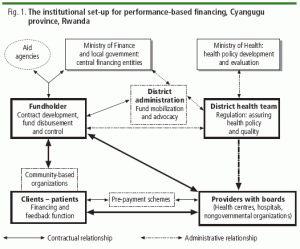 (this is just an example of what I am talking about)
(this is just an example of what I am talking about)
The sub divisions in each district or sub districts are important for the delivery of health services. They are more local, focusing on outpatients, follow-ups, outreach and delivery programs, public health services, health education and information systems and support/supervision of village health workers and local traditional healers.
INTERMEZZO OF THE “joy-fool” number 2!
Boxinggloves/Bazooka – again.. Per is a funny man. This exercise came with a little song we learnt where you throw your fists up in the air during it. Apparently he made this up for his son when he was first starting school and was nervous (so it was a thing he could do to remind him not to be scared). How cute!
Scandinavian PHC:
- Free and accessible
- Cost-effective and efficient
- Comprehensive and sustained by a mutually supportive referral system to secondary care
- Structured according to the Alma-Ata ideals
- PHC principles (primary): – 90%
- Evolves from economic conditions and sociocultural and political characteristics
- Addresses main health problems by promotive, preventive, curative and rehabilitative services
- Includes health education, nutrition, safe water, sanitation, maternal and child health, family planning, immunisation, prevention and treatment of common diseases and essential drug schemes
- PHC principles (secondary): – 10%
- Involves all related sectors
- Requires and promotes community-involvement and self-reliance and participation
- Is sustained by integrated referral systems
- Relies on health workers
INTERMEZZO OF THE “joy-fool”
Duck dance – kind of like the chicken dance but in Danish! We learnt the words for wing, wings, foot, both feet, hips/tail , head and beak. In English it went: flap on wing, flap two wings, stomp one foot (while still flapping), stomp both feet and flap both wings, shake your tail feathers while you do this, add in the head shake and then stop and clap (close your beak) – this was awesome, everyone was laughing! What a great exercise – I will try to find a video so you know what I am talking about!
Since the “Health of all 2000” was not met, there were new goals set labelled the millennium development goals 2015! These include:
- Eradicate extreme poverty and hunger
- Achieve universal primary education
- Promote gender equality and empower women
- Reduce child mortality
- Improve maternal health
- Combat HIV/AIDS, malaria and other diseases
- Ensure environmental sustainability
- Develop a global partnership for development
Between 2015 and 2035 there are three domains of health challenges:
- High rates of avertable infectious, child and maternal deaths à unfinished agenda
- Demographic change and shift in GBD towards NCDs and injuries à emerging agenda
- Impoverishing medical expenses, unproductive cost increases à cost agenda
Now there are new goals set – Sustainable development goals 2015-2030

- End poverty
- End hunger
- Well-being
- Ensure healthy lives and promote well-being for all at all ages
- 3.1 reduce maternal mortality to less than 70 per 100,000 live births
- 3.2 end preventable deaths of newborns and under five children
- Ensure healthy lives and promote well-being for all at all ages
- 3.3 end epidemics of AIDS, TB, NTDs, combat hepatitis and other infectious diseases
- 3.4 reduce by 1/3 premature mortality from NCDs and promote mental health
- 3.5 strengthen prevention and treatment of substance abuse and harmful use of alcohol
- 3.6 by 2020 halve global deaths injuries from road traffic accidents
- 3.7 ensure universal access to sexual and reproductive care services
- 3.8 achieve universal health coverage including financial risk protection and quality services
- 3.9 reduce number of deaths from hazardous chemicals, pollution and contamination
- 3.10 strengthen implementation of framework convention on tobacco control
- 3.11 support research and development of vaccines and medicines for countries
- 3.12 increase health financing and recruitment and development of the workforce
- 3.13 strengthen capacity for early warning, risk reduction and management of GH risks
- Quality education
- Gender equality
- Water and sanitation for all
- Affordable and sustainable energy
- Decent work for all
- Technology to benefit all
- Reduce inequality
- Safe cities and communities
- Responsible consumption by all
- Stop climate change
- Protect the ocean
- Take care of the earth
- Live in peace
- Mechanisms and partnerships to reach the goals
Oh yes.. those are the goals – to me I look at those and I feel like a grade 5 class wrote these. They are so big and so broad (although they are broken down further – as I showed you with Goal 3). I don’t think there is much confidence that we will get to this point anytime soon, maybe by 2030 but with our track record in meeting past goals, I don’t think anyone should keep their hopes up. There are 4 key messages to do with global health 2035 which are – 1. A grand convergence in health is achievable within our lifetime. 2. Fiscal policies are a powerful, underused lever for curbing non-communicable disease and injuries. 3. The returns from investing in health are extremely impressive. 4. Pro-poor pathways to universal health coverage are an efficient way to achieve health and financial protection. But which countries need convergence? The 4C countries! (Cuba, China, Chile and Costa Rica). What about funding? Sources for income to fund convergence can come from economic growth, mobilization of domestic resources, inter-sectoral reallocations and efficiency gains and development assistance for health.
To finish we talked about the prevalence of disease and problem areas compared to the number of educated doctors and health workers – The problem – people are dying for lack of basic healthcare knowledge – 400 children and 20 young women will die in the next half hour due to lack of simple, inexpensive life-saving interventions.
These lectures (although not my area of interest generally ) were very powerful and interesting. I don’t normally enjoy the public health side of things but these lectures were actually very interesting and had some really valid and good points throughout. Per was very engaging and knew his stuff! Plus the duck dance was pretty fun!
After class however… I went to the “spiral” tower as I call it. It is the church of our saviours that has a very tall tower standing at 90 meters above Copenhagen. You can climb stairs all the way to the top, and most of them are spiral stairs that go up around and around until you get to the dome at the top! From there you can only fit on person at a time, and let me tell you.. I barely fit so it was a little freaky, especially since we are having such strong winds the past few days.
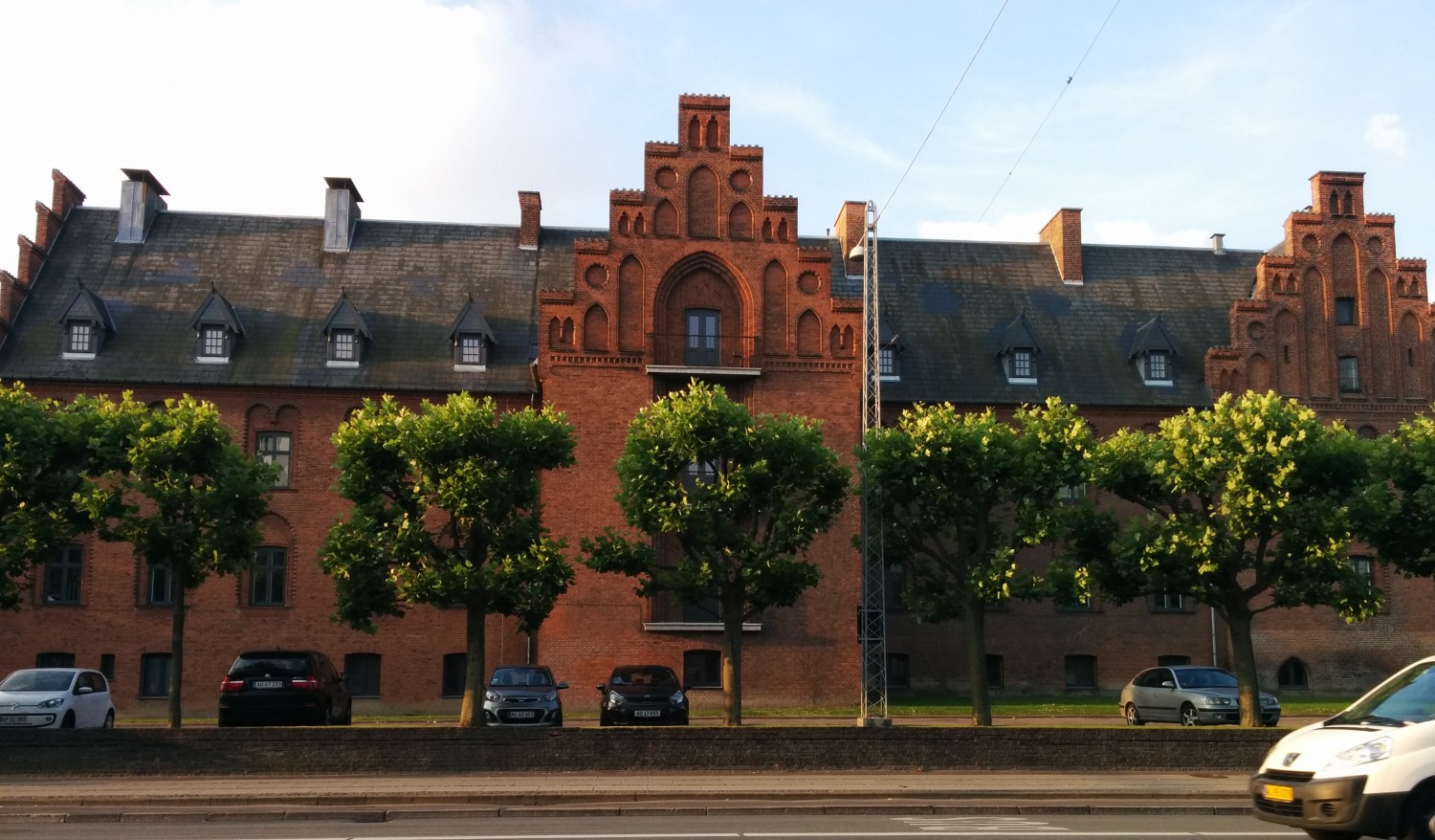
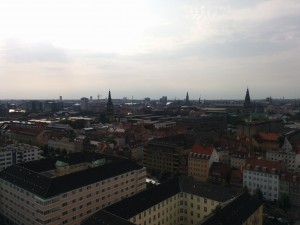
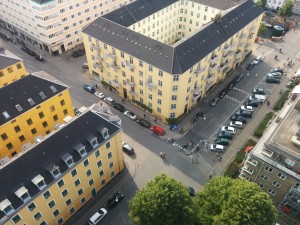
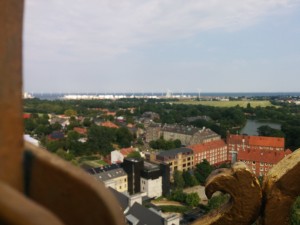


 Also in the area is Christiania, which (if you don’t know) is pretty much a city of its own. It is a hippy town… they have their own laws, rules, education system and everything. Weed is legal in there. You can’t bring in cameras (so no pictures to share) but they sell weed and weed food, as well as other things haha. It was a great experience but very weird at the same time. I am glad I went and I would recommend it as there is live music there on stage on the weekends and it is just a great thing to see!
Also in the area is Christiania, which (if you don’t know) is pretty much a city of its own. It is a hippy town… they have their own laws, rules, education system and everything. Weed is legal in there. You can’t bring in cameras (so no pictures to share) but they sell weed and weed food, as well as other things haha. It was a great experience but very weird at the same time. I am glad I went and I would recommend it as there is live music there on stage on the weekends and it is just a great thing to see!